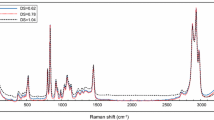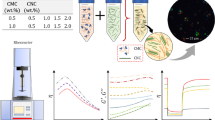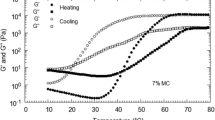Abstract
Through viscosity measurements, concentration and temperature dependences of viscosity of sodium carboxymethylcellulose (CMC) solution were recorded. Effects of glycerin, mechanical shearing and several electrolytes on the CMC solution were also determined. Results showed that the viscosity dependence on concentration obeyed the Huggins and Kramer equation, the dependence on temperature complied with the Arrhenius equation. CMC chain could synergize with glycerin, konjac glucomannan (KGM), and aluminum sulfate 18-hydrate. Sodium chloride, hydrochloric acid, and calcium dichloride reduced the viscosity of the CMC solution. By suggesting the ion-binding and hydrogen bond as the major form of the electrostatic interaction in the CMC solution, the synergistic and pseudoplastic phenomena as well as the maximum over stirring time were reasonably explained.










Similar content being viewed by others
References
Andreeva IA, Romanova LG, Sushko VA (1992) Investigation of rheological properties: viscosity and nuclear-relaxational characteristics of gels on the basis of Na-CMC solutions with chromium chloride. Kolloidnyi Zhurnal 54(2):21–27
Andriana EV, Tunc KP, Sandeep KP et al (2002) Rheological characterization of carboxymethylcellulose solution under aseptic processing conditions. J Food Process Eng 25(1):41–61
Barba C, Montane D, Farriol X et al (2002) Synthesis and characterization of carboxymethylcelluloses from non-wood pulps II. Rheological behavior of CMC in aqueous solution. Cellulose 9(3–4):327–335
Dobrynin AV, Rubinstein M (2005) Theory of polyelectrolytes in solutions and at surfaces. Prog Polym Sci 30:1049–1118
Elliot JH, Ganz AJ (1974) Some rheological properties of sodium carboxymethylcellulose solutions and gels. Rheologica Acta 13(4–5):670–674
Florjancic U, Zupancic A, Zumer M (2002) Rheological characterization of aqueous polysaccharide mixtures undergoing shear. Chemical and Biochemical Eng 16(3):105–118
Hess W, Klein R (1983) Generalized hydrodynamics of systems of Brownian particles. Adv Phys 32:173–283
Jayabalan M (1989) Newtonian behaviour of sheared aqueous carboxymethylcellulose solution on aging. Br Polym 21(3):233–235
Kunimasa M, Biman B, Arun Y (2004) Self-consistent mode-coupling theory for the viscosity of rodlike polyelectrolyte solutions. J Chem Phys 121(16):8120–8127
Lin CX, Ko SY (1995) Effects of temperature and concentration on the steady shear properties of aqueous solutions of Carbopol and CMC. Int Commun in Heat and Mass Transfer 22(2):157–166
Markus A, Andreas B, Stephan F (1997) Quantitative description of the intrinsic viscosity of branched polyelectrolytes. Macromolecules 30:2700–2704
Matsumoto T, Mashiko K (1988) Influence of added salt on dynamic viscoelasticity of carboxymethylcellulose aqueous systems. Polym Eng and Sci 28(6):393–402
Mothé CG, Rao MA (1999) Rheological behavior of aqueous dispersions of cashew gum and gum arabic: effect of concentration and blending. Food Hydrocolloids 13:501–506
Nishida K, Ando Y, Enomoto M (1982) Interaction of 5-fluorouracil with sodium carboxymethylcellulose. Colloid and Polymer Sci 206(5):511–513
Okatova OV, Lavrenko PN, Dautzenberg H (1990) Polyelectrolyte effects in diffusion and viscosity phenomena in water-cadoxene solutions of carboxymethylcellulose. Polymer Science USSR (English Translation of Vysokomolekulyarnye Soyedineniya Series A) 32(3):533–539
Rossi S, Bonferoni MC, Ferrari F et al (1996) Characterization of mucin interaction with three viscosity grades of sodium carboxymethylcellulose. Comparison between rheological and tensile testing. Eur J Pharm Sci 4(3):189–199
Rubinstein M, Colby RH (2003) Polymer physics. Oxford University Press, New York, p 337
Thomas H, Ute H, Dieter K (2003) Viscosity behaviour of multivalent metal ion-containing carboxymethyl cellulose solutions. Angewandte Makromolekulare Chemie 220(1):123–132
Trivedi HC, Patel RD (1987) Studies on carboxymethylcellulose: 3. Effect of polyion charge on specific viscosity. Polymer Communications (Guildford, England) 28(5):158–159
Xiao CB, Lu YS, Liu HJ, Zhang LN (2001) Preparation and characterization of konjac glucomannan and sodium carboxymethylcellulose blend films. J Appl Polym Sci 80(1):26–31
Author information
Authors and Affiliations
Corresponding author
Rights and permissions
About this article
Cite this article
Yang, X.H., Zhu, W.L. Viscosity properties of sodium carboxymethylcellulose solutions. Cellulose 14, 409–417 (2007). https://doi.org/10.1007/s10570-007-9137-9
Received:
Accepted:
Published:
Issue Date:
DOI: https://doi.org/10.1007/s10570-007-9137-9




